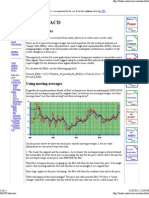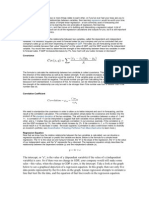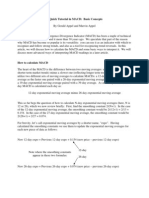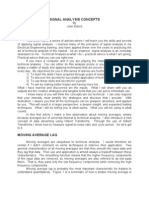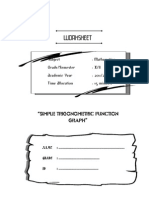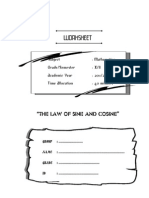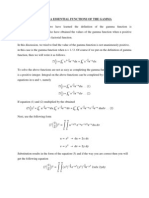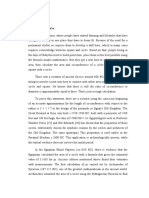Exponential Moving Average
Uploaded by
Azizah NoorExponential Moving Average
Uploaded by
Azizah NoorSTOCK EXCHANGE MATHEMATICS
NOOR AZIZAH
5/19/2012
EXPONENTIAL MOVING AVERAGE
Critics argue, Simple Moving Average is too simple because it gives equal weight to each data. They view the most recent data should be given greater weight in the formula because it is more relevant to the future price movements. To solve this problem, made Exponential Moving Average (EMA), which gives greater weight to recent data in calculating the moving average.
5/19/2012
EXPONENTIAL MOVING AVERAGE
5/19/2012
EXPONENTIAL MOVING AVERAGE
The formula to calculate an exponential moving average is as follows:
The coefficients represents the degree of weighting decrease, a constant smoothing factor between 0 and 1. A higher discounts older observations faster. Alternatively, may be expressed in terms of N time periods, where = 2/(N+1).
5/19/2012
EXPONENTIAL MOVING AVERAGE
The following shows the calculation results of exponential moving average on Eastman Kodak stock. For the first period EMA, the calculation is used as a simple moving average of the previous period EMA (yellow block to the period-10). Of period-11 forward, the next period of the previous EMA will be used in the calculations. The calculation of the period-11 broken down as follows:
5/19/2012
EXPONENTIAL MOVING AVERAGE
Example, table:
5/19/2012
EXPONENTIAL MOVING AVERAGE
Example, graphic:
5/19/2012
EXPONENTIAL MOVING AVERAGE
The difference between SMA and EMA
For this example, which uses only 20 days of the data market, the difference is minimal, although still distinct. Exponential moving average is consistently closer to the actual price. On average, closer EMA 3/8 points to the actual price of the SMA.
5/19/2012
EXPONENTIAL MOVING AVERAGE
5/19/2012
EXPONENTIAL MOVING AVERAGE
Simple Moving Average
Exponential Moving Average Move quickly and well to show the latest price changes. More prone to get a false signal
Pro
Featuring subtle graphics that eliminates false signals. Moving slowly, which can lead to signal late in the buying and selling
Kontra
5/19/2012
EXPONENTIAL MOVING AVERAGE
THANK YOU
You might also like
- Moving Average and Exponential Smoothing ModelsNo ratings yetMoving Average and Exponential Smoothing Models13 pages
- Data Interpretation Guide For All Competitive and Admission ExamsFrom EverandData Interpretation Guide For All Competitive and Admission Exams2.5/5 (6)
- Noor Azizah - Exponential Moving Average1No ratings yetNoor Azizah - Exponential Moving Average17 pages
- 3.Exponential Moving Averages (EMA) in Forex TradingNo ratings yet3.Exponential Moving Averages (EMA) in Forex Trading6 pages
- A Comparative Study of Moving Averages: Simple, Weighted and ExponentialNo ratings yetA Comparative Study of Moving Averages: Simple, Weighted and Exponential10 pages
- The Macd Indicator Revisited by John F. Ehlers100% (3)The Macd Indicator Revisited by John F. Ehlers11 pages
- Operations Manager For Excel (C) 1997-2003, User Solutions, IncNo ratings yetOperations Manager For Excel (C) 1997-2003, User Solutions, Inc18 pages
- Mie 1628H - Big Data Final Project Report Apple Stock Price PredictionNo ratings yetMie 1628H - Big Data Final Project Report Apple Stock Price Prediction10 pages
- QMT 3001 Business Forecasting Term ProjectNo ratings yetQMT 3001 Business Forecasting Term Project30 pages
- Alphee Lavoie - Neural Networks in Financial AstrologyNo ratings yetAlphee Lavoie - Neural Networks in Financial Astrology11 pages
- Ever Closer To Heaven An Optimum-Currency-Area Index For European Countries - Bayoumi TamimNo ratings yetEver Closer To Heaven An Optimum-Currency-Area Index For European Countries - Bayoumi Tamim16 pages
- Forecasting Methods - An Overview of Models and Techniques: David A. Dickey, N. C. State U., Raleigh, N. CNo ratings yetForecasting Methods - An Overview of Models and Techniques: David A. Dickey, N. C. State U., Raleigh, N. C17 pages
- Basic Usage of Sas Software To Forecast A Time SeriesNo ratings yetBasic Usage of Sas Software To Forecast A Time Series10 pages
- The Measurement of Productive Efficiency and Productivity ChangeNo ratings yetThe Measurement of Productive Efficiency and Productivity Change4 pages
- 03 ASAP TimeSeriesForcasting - Day3 - 4-1No ratings yet03 ASAP TimeSeriesForcasting - Day3 - 4-135 pages
- Alphee Lavoie - Neural Networks in Financial Astrology PDFNo ratings yetAlphee Lavoie - Neural Networks in Financial Astrology PDF12 pages
- More On The As-Ad Model: (Supplementary Notes For Chapter 7)No ratings yetMore On The As-Ad Model: (Supplementary Notes For Chapter 7)24 pages
- Bayoumi, T. and Eichengreen, B. Ever closer to heaven. An optimum currency area index for European countriesNo ratings yetBayoumi, T. and Eichengreen, B. Ever closer to heaven. An optimum currency area index for European countries15 pages
- Bridging_the_Gap_between_Economic_ModellNo ratings yetBridging_the_Gap_between_Economic_Modell14 pages
- Zero Lag: Jack Hutson, "Stocks & Commodities", (Elizabeth, Please Help With This - My Guess Is 1982-1984)No ratings yetZero Lag: Jack Hutson, "Stocks & Commodities", (Elizabeth, Please Help With This - My Guess Is 1982-1984)8 pages
- Price Prediction Evolution: From Economic Model To Machine LearningNo ratings yetPrice Prediction Evolution: From Economic Model To Machine Learning7 pages
- 4.Simple vs. Exponential Moving Averages in Forex - HowToTrade.comNo ratings yet4.Simple vs. Exponential Moving Averages in Forex - HowToTrade.com7 pages
- Start Predicting In A World Of Data Science And Predictive AnalysisFrom EverandStart Predicting In A World Of Data Science And Predictive AnalysisNo ratings yet
- WORKSHEET - Draw Trigonometric Function GraphNo ratings yetWORKSHEET - Draw Trigonometric Function Graph7 pages
- Worksheet: "The Position of Point, Line, and Plane in A Space "No ratings yetWorksheet: "The Position of Point, Line, and Plane in A Space "4 pages
- Fungsi Pembangkit Moment & Teorema ChebisevNo ratings yetFungsi Pembangkit Moment & Teorema Chebisev13 pages
- A. Background: Mathematical Modeling in EonomicsNo ratings yetA. Background: Mathematical Modeling in Eonomics25 pages
- Elliott Wave Timing Beyond Ordinary Fibonacci MethodsFrom EverandElliott Wave Timing Beyond Ordinary Fibonacci Methods
- Data Interpretation Guide For All Competitive and Admission ExamsFrom EverandData Interpretation Guide For All Competitive and Admission Exams
- 3.Exponential Moving Averages (EMA) in Forex Trading3.Exponential Moving Averages (EMA) in Forex Trading
- A Comparative Study of Moving Averages: Simple, Weighted and ExponentialA Comparative Study of Moving Averages: Simple, Weighted and Exponential
- Operations Manager For Excel (C) 1997-2003, User Solutions, IncOperations Manager For Excel (C) 1997-2003, User Solutions, Inc
- Mie 1628H - Big Data Final Project Report Apple Stock Price PredictionMie 1628H - Big Data Final Project Report Apple Stock Price Prediction
- Alphee Lavoie - Neural Networks in Financial AstrologyAlphee Lavoie - Neural Networks in Financial Astrology
- Ever Closer To Heaven An Optimum-Currency-Area Index For European Countries - Bayoumi TamimEver Closer To Heaven An Optimum-Currency-Area Index For European Countries - Bayoumi Tamim
- Forecasting Methods - An Overview of Models and Techniques: David A. Dickey, N. C. State U., Raleigh, N. CForecasting Methods - An Overview of Models and Techniques: David A. Dickey, N. C. State U., Raleigh, N. C
- Basic Usage of Sas Software To Forecast A Time SeriesBasic Usage of Sas Software To Forecast A Time Series
- The Measurement of Productive Efficiency and Productivity ChangeThe Measurement of Productive Efficiency and Productivity Change
- Alphee Lavoie - Neural Networks in Financial Astrology PDFAlphee Lavoie - Neural Networks in Financial Astrology PDF
- More On The As-Ad Model: (Supplementary Notes For Chapter 7)More On The As-Ad Model: (Supplementary Notes For Chapter 7)
- Bayoumi, T. and Eichengreen, B. Ever closer to heaven. An optimum currency area index for European countriesBayoumi, T. and Eichengreen, B. Ever closer to heaven. An optimum currency area index for European countries
- Zero Lag: Jack Hutson, "Stocks & Commodities", (Elizabeth, Please Help With This - My Guess Is 1982-1984)Zero Lag: Jack Hutson, "Stocks & Commodities", (Elizabeth, Please Help With This - My Guess Is 1982-1984)
- Price Prediction Evolution: From Economic Model To Machine LearningPrice Prediction Evolution: From Economic Model To Machine Learning
- 4.Simple vs. Exponential Moving Averages in Forex - HowToTrade.com4.Simple vs. Exponential Moving Averages in Forex - HowToTrade.com
- Start Predicting In A World Of Data Science And Predictive AnalysisFrom EverandStart Predicting In A World Of Data Science And Predictive Analysis
- Gale Researcher Guide for: Econometric ModelsFrom EverandGale Researcher Guide for: Econometric Models
- Worksheet: "The Position of Point, Line, and Plane in A Space "Worksheet: "The Position of Point, Line, and Plane in A Space "
























